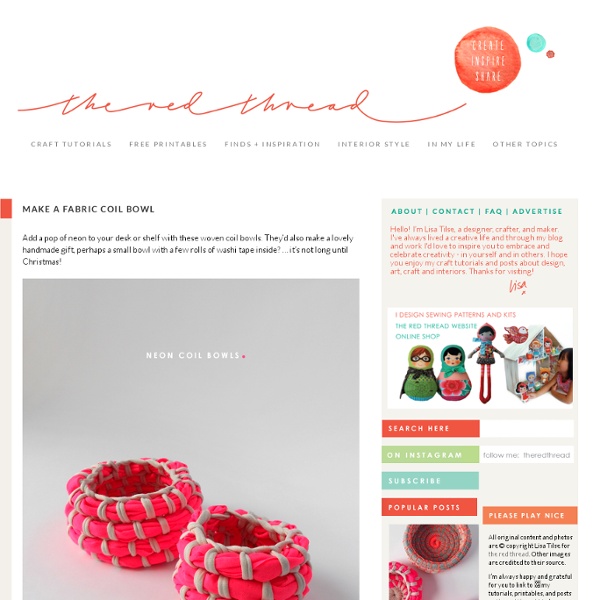How to make a fabric coil bowl or basket

the red thread
Quick Tip: Make a Set of Cool Crochet Buttons
In this tutorial we’ll be making some cute and easy crochet buttons. The pattern uses US terms and stitches include double crochet (dc); chain (ch); and a magic ring. Supplies Yarn in a main and a contrast colour (I used Drops Paris cotton yarn by Garnstudio).A crochet hook in a size suitable for the yarn you’re using (I used a 4mm hook here).A darning needle for sewing in the ends.A pair of scissors. Step 1: Make a Magic Ring Using the main colour yarn, make a magic ring and secure with a stitch. Step 2: Crochet the Button Chain 2 (counting as 1 dc), and work 11 double crochet in the ring, and pull it to close, creating a circle. Step 3: Needle Join Cut the yarn and pull the end through the loop on your hook. Close the circle by putting the needle through the top of your first double crochet (ie. not the starting two chains)… …and back again through the back loop of the last stitch. Step 4: Embellish Your Buttons You can now embellish your buttons. And your colour ridge button is finished!
How To Make Vegetable Dye
Previous image Next image Choose the color. I found a page from an old book all about creating vegetable dyes! What You Need MaterialsWool (to be dyed)Alum (potassium aluminum sulphate)Cream of TartarLarge saucepan or tall potContainer to store treated wool*Pick a color from the list below to find the herb, plant, or bark you will need. EquipmentStovetopScaleWooden sticks, dowels, or knitting needlesRubber gloves Instructions *Please read any special instructions for your specific color before starting this process. 1. 2. 3.Prepare the Plant Once you choose a color, put the plant in cold water and bring it to a slow boil. 4. 5. Fresh birch leaves = Yellow Use 2.2 pounds or 1 kilogram of birch leaves. Additional Notes:For lichens, you do not need to use mordant. Any other great veggie and plant dye tips out there? (Images: Green Mountain Etsy Shop, Hello Yarn, Gleason's Fine Woolies, GypsyTreeBags, Sweet Georgia Yarns, The Dye Dept., BeadBag)
How to do sashiko stitching - How to Sashiko Stitch - A Threaded Needle - (Powered by CubeCart)
How to do sashiko stitching: Materials for sashiko stitching are minimal: fabric to stitch your designs on, a sashiko needle, thread, scissors, a sashiko pattern, and some white fusible lightweight non woven interfacing. It is worth it to buy sashiko needles, they make stitching easier. You can stitch on any fabric but it is important to test it by stacking up some stitches on your needle and pulling them through. It is a good practice to pre wash your fabrics before you begin. Transfer your design: Start by transferring the sashiko design to your fabric. Tip: Use a piece of interfacing larger than your sashiko project, and trace the cutting, sewing and any other pattern markings onto it as well. Lift the interfacing and position it on the back of your fabric, again with the glue side down. Begin your stitching: Thread your needle with a comfortable length of thread (about 24 – 30″) and choose a long vertical or horizontal line (if possible) to begin your stitching.
Related:
Related:



